.

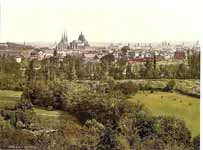
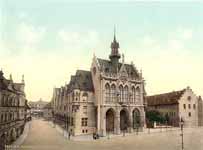
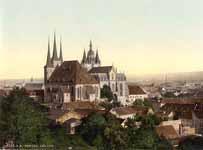
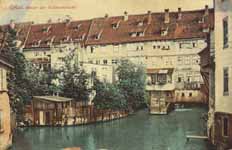
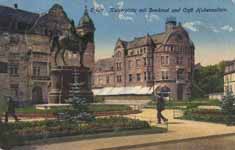

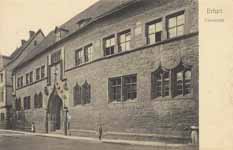
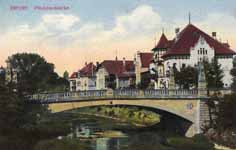

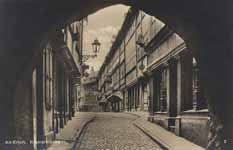
Erfurt
Erfurt (German pronunciation: [ˈɛʁfʊʁt][2]) is the capital city of Thuringia and the main city nearest to the geographical centre of Germany, located 100 km SW of Leipzig, 150 km N of Nuremberg and 180 km SE of Hannover. Erfurt Airport can be reached by plane via Munich. It lies in the southern part of the Thuringian Basin within the wide valley of Gera River, a tributary of the Unstrut. To the south, the city is surrounded by the Steigerwald forest.
In 2010, Erfurt had a population of over 200,000 and is part of the Erfurt-Weimar-Jena metropolitan area with a population of about 500,000.
History
Erfurt, woodcut from the Nuremberg Chronicle, 1493
Old synagogue (the oldest in Europe)
Old university (1392)
Citadel on Petersberg
Town hall
Angermuseum
Main train station
Christmas market
Mariendom at night
Wenigemarkt square
Erfurt is an old Germanic settlement. The oldest evidence of human settlement dates from the prehistoric era; archeological finds from the north of Erfurt revealed human traces from the paleolithic period, ca. 100,000 BCE. The Erfurt-Melchendorf dig showed a settlement from the neolithic period. The Thuringii inhabited the Erfurt area ca. 480 and gave their name to Thuringia ca. 500.
The town is first mentioned in 742 under the name of "Erphesfurt": in that year, Saint Boniface writes Pope Zachary to tell him that he had established three dioceses in Thuringia, one of which "in a place called Erphesfurt, which for a long time has been inhabited by pagan natives." All three dioceses (the other two were Würzburg and Buraburg) were confirmed by Zachary the next year, though later Erfurt was brought into the diocese of Mainz.[3] That the place was populous already is borne out by archeological evidence, which includes 23 graves and six horse burials from the sixth and seventh centuries.[4]
Throughout the Middle Ages, it was an important trading town because of its location, near a ford across the Gera river. Together with the other five Thuringian woad-towns of Gotha, Tennstedt, Arnstadt and Langensalza it was the centre of the German woad trade.
In 1349, during the wave of pogroms which followed the Black Death across Europe, the Jews of Erfurt were rounded up, with more than 100 killed and the rest driven from the city. Recently, the medieval synagogue has been discovered beneath newer buildings, and is being restored (completion expected 2009). In 1392, the University of Erfurt, where Martin Luther was matriculated, was founded. One of the leading German universities for many centuries, it fell upon hard times in the early 19th century, and was forced to close in 1816. It was refounded in 1994 by the Thuringian state parliament and has regained its status as a leading German academic and research institution.
In 1664, the city and surrounding area were brought under the dominion of the Electorate of Mainz. Erfurt became part of the Kingdom of Prussia in 1802. In the Capitulation of Erfurt the city, its 12,000 defenders, and the Petersberg fortress were handed over to the French on 16 October 1806. The city became part of the First French Empire in 1806 as Principality of Erfurt, and was returned to Prussia in 1815 after the Napoleonic Wars. Although enclosed by Thuringian territory in the west, south and east, the city remained part of the Prussian Province of Saxony until 1944. The city was the site of the failed Erfurt Union of German states in 1850.
The Erfurt Program was adopted by the Social Democratic Party of Germany during its congress at Erfurt in 1891.
In 1914 The Erfurt Company JA Topf & Sons began the manufacture of crematoria later becoming the market leader in this industry. Under the Nazi's JA Topf & Sons supplied specially developed crematoria, ovens and associated plant to the death camps at Auschwitz-Birkenau and Mauthausen. On 27 January 2011 a memorial and museum dedicated to the Holocaust victims killed using Topf ovens was opened at the former company premises in Erfurt.
Bombed as a target of the Oil Campaign of World War II, Erfurt suffered only limited damage and was captured on 12 April 1945, by the US 80th Infantry Division.[5] On 3 July, American troops left the city and the city became part of the Soviet Zone of Occupation and East Germany. On 19 March 1970 the East and West German Chancellors Willi Stoph and Willy Brandt met in Erfurt, the first such meeting since the division of Germany. After reunification, the city became the capital of the re-established state of Thuringia.
Main sights
Erfurt has preserved an intact medieval city centre. The city is known for its two churches, Erfurt Cathedral (Mariendom) and Severikirche, which stand side by side and together form the emblem of the city. Both churches tower above the townscape and are accessible via huge open stairs called Domstufen. Another remarkable site is the Krämerbrücke, a bridge crossing the narrow Gera River. The bridge is covered with 32 inhabited buildings. It was built in 1325 with a church on either bridgehead, one of which, the Ägidienkirche, is still functional. The Augustinerkloster is an old Augustinian monastery. Martin Luther studied at the university and lived in the Augustinerkloster for a few years after 1505.
The eleventh century Erfurt Synagogue is thought to be the oldest synagogue building still standing in Europe. It is now a museum displaying the Erfurt Treasure.
Culture
Martin Luther attended the University of Erfurt and received his bachelor's and master's degrees of theology there. Luther lived there as a student from 1501 to 1511 and, as a monk, from 1505 to 1511.
The city is the birthplace of one of Johann Sebastian Bach's cousins, Johann Bernhard Bach, as well as Johann Sebastian Bach's father Johann Ambrosius Bach. Bach's parents were married in 1668 in a small church, the Kaufmannskirche (Merchant's Church), that still exists on the main square, Anger.
The sociologist Max Weber was born in Erfurt,[6] and the theologian and philosopher Meister Eckhart was Prior of Erfurt's Dominican Order.
Johann Pachelbel served as organist at the Prediger church in Erfurt. Pachelbel composed approximately seventy pieces for organ while in Erfurt. After 1906 the composer Richard Wetz lived in Erfurt and became the leading person in the town's musical life. His major works were written here, including three symphonies, a Requiem and a Christmas Oratorio.
Erfurt Theater
Since 2003, the modern new built opera house is home to Theater Erfurt and its Philharmonic Orchestra. The "grand stage" section has 800 seats and the "studio stage" can hold 200 spectators. In September 2005, the opera Waiting for the Barbarians by Philip Glass premiered in the opera house. The Erfurt Theater has been source of controversy recently. In 2005 a performance of Engelbert Humperdinck's opera Hänsel und Gretel stirred up the local press since the performance contained suggestions of pedophilia and incest. The opera was advertised in the program with the addition "for adults only".
On 12 April 2008, a version of Verdi's opera Un ballo in maschera directed by Johann Kresnik opened at the Erfurt Theater. The production stirred deep controversy by featuring nude performers in Mickey Mouse masks dancing on the ruins of the World Trade Center and a female singer with a painted on Hitler toothbrush moustache performing a straight arm Nazi salute, along with sinister portrayals of American soldiers, Uncle Sam, and Elvis Presley impersonators. The director described the production as a populist critique of modern American society, aimed at showing up the disparities between rich and poor. The controversy prompted one local politician to call for locals to boycott the performances, but this was largely ignored and the premiere was sold out.[7]
Transport
Erfurt has an Airport and lies on two Bundesstraßen (federal motorways):
Bundesstraße 4 from Ilmenau in south to Nordhausen in north and
Bundesstraße 7 from Gotha in west to Weimar in east.
Also there are two Autobahnen crossing each other at Erfurter Kreuz nearby:
Bundesautobahn 4 from Frankfurt am Main to Görlitz (via Dresden) and
Bundesautobahn 71 from Würzburg to Sangerhausen (and Halle (Saale) via Bundesautobahn 38).
There have been trams in the city since 1883. Today there are six tram lines to most of the parts of Erfurt, supplemented by several bus lines
Railways run from Erfurt main station to:
Berlin via Weimar, Naumburg, Halle (Saale) and Wittenberg,
Dresden via Weimar, Naumburg, Leipzig and Riesa,
Chemnitz via Weimar, Jena and Gera,
Frankfurt am Main via Gotha, Eisenach, Bebra, Fulda and Hanau,
Würzburg via Arnstadt, Suhl, Meiningen, Bad Neustadt and Schweinfurt,
Ilmenau via Arnstadt,
Saalfeld (ICE-connections to Nuremberg and Munich) via Arnstadt,
Nordhausen via Sondershausen,
Magdeburg via Sömmerda, Sangerhausen, Staßfurt and Schönebeck and
Kassel/Göttingen via Gotha, Bad Langensalza, Mühlhausen, Leinefelde-Worbis and Heiligenstadt.
Universities
University of Applied Sciences Erfurt
The University of Applied Sciences Erfurt was founded on 1991. It is characterised by a combination of scientific training and its practical applications. In the winter term 2008/09 there studied approximately 4600 students.
Faculties
Faculty of Social Affairs
Faculty of Business, Logistics and Transport
Faculty of Landscape Architecture, Horticulture and Forestry
Faculty of Architecture
Faculty of Civil Engineering and Conservation/Restoration
Faculty of Building Services Engineering and Computer Science
University of Erfurt
The University of Erfurt was founded in 1994 and is thus the youngest public university in Germany. It sees itself in the tradition of the historic University that had been there from 1379 to 1816. The historic university is regarded as the oldest university in Germany (followed by Heidelberg (1386) and Cologne (1388)). In the winter term 2011/12 there were approximately 5500 enrolled students.
Faculties
Faculty of Political Science
Arts Faculty (Faculty of Philosophy)
Faculty of Education
Faculty of Catholic Theology
Max Weber Center for Advanced Cultural and Social Studies
Industry
Erfurt is the home of the Born Feinkost, producing the mustard served with the Thuringian Bratwurst. In the years just after World War I, Ortgies and Co., succeeded by Deutsche Werke, produced the popular Ortgies 7.65 mm Semi-Automatic Pistol in Erfurt.
Twin towns
See also: List of twin towns and sister cities in Germany
Erfurt is twinned with:
Hungary Győr, Hungary, since 1971
Lithuania Vilnius, Lithuania, since 1972
Poland Kalisz, Poland, since 1982[8]
Germany Mainz, Germany, since 1988
France Lille, France, since 1991
United States Shawnee, Kansas, United States, since 1993
Argentina San Miguel de Tucumán, Argentina, since 1993
Bulgaria Lovech, Bulgaria, since 1996
Israel Haifa, Israel, since 2000
China Xuzhou, People's Republic of China, since 2005
Mali Kati, Mali, since 2011
References
^ "Bevölkerung nach Gemeinden, erfüllenden Gemeinden und Verwaltungsgemeinschaften" (in German). Thüringer Landesamt für Statistik. 27 June 2011.
^ Mangold, Max (2005). "Erfurt". Das Aussprachewörterbuch. Mannheim, Leipzig, Wien, Zürich: Duden Verlag. p. 311. ISBN 978-3-411-04066-7. Retrieved 2011-06-22.
^ Heinemeyer, Karl (2004). "Bonifatius in Mitteldeutschland". In Hardy Eidam, Marina Moritz, Gerd-Rainer Riedel, Kai-Uwe Schierz (in German). Bonifatius: Heidenopfer, Christuskreuz, Eichenkult. Stadtverwaltung Erfurt. pp. 73–87.
^ Schmidt, Christoph G. (2004). "Im Machtbereich der Merowinger: Politische und gesellschaftliche Strukturen in Thüringen vom 6. bis 8. Jahrhundert". In Hardy Eidam, Marina Moritz, Gerd-Rainer Riedel, Kai-Uwe Schierz (in German). Bonifatius: Heidenopfer, Christuskreuz, Eichenkult. Stadtverwaltung Erfurt. pp. 39–56.
^ Stanton, Shelby, World War II Order of Battle: An Encyclopedic Reference to U.S. Army Ground Forces from Battalion through Division, 1939-1946, Stackpole Books (Revised Edition 2006), p. 150
From Wikipedia, All text is available under the terms of the GNU Free Documentation License

